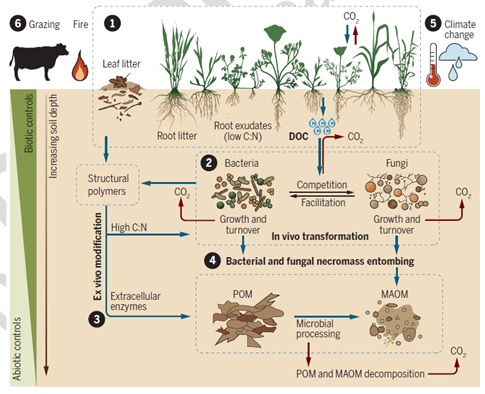
Grasslands have the capability to store carbon, functioning as an important tool in a battle against climate change. While scientific interest in grassland soil for carbon sequestration is not new, researchers from the Chinese Academy of Sciences and Colorado State University have provided a fresh analysis of the existing research on soil carbon sequestration in grasslands. According to the researchers, they apply a new paradigm of soil organic matter formation to their evaluation and -- through the lens of this paradigm and with consideration for regional differences -- evaluate grassland management for carbon sequestration.
The review article was published in Science on Aug. 4.
"This is the first review which applies the new paradigm of soil organic matter formation and persistence to both discuss the effect of global changes on grasslands' soil organic carbon and estimate the potentials of soil organic carbon sequestration of global grasslands," said first author BAI Yongfei of the Institute of Botany of the Chinese Academy of Sciences.
While storing carbon in grassland soil has been proven to be an attainable strategy for removing it from the atmosphere, the specifics of global grassland soil carbon sequestration — how, where and how much — still require more research for a deeper understanding and to form best practice recommendations, according to the researchers.
"In the past decade, there has been a paradigm shift in the understanding of the processes contributing to soil organic matter formation and persistence, which have highlighted the key role of microbial transformations and necromass on soil organic carbon accrual," Cotrufo said.
The majority of organic carbon soil is either particulate organic matter (POM), which is formed from the fragmentation of plant and microbial residues, or mineral-associated organic matter (MAOM), which is formed from single small molecules that are leached from plant residues or exuded from plant roots. MAOM contributes to longer-term carbon sequestration in soil than POM because of its strong chemical bonding to minerals and physical protection in fine aggregates. With this understanding, the researchers used the existing literature to explore how soil carbon sequestration changes with grassland types, soil properties and climate conditions.
"Our analysis presents capacities by different world regions and management strategies, thus facilitating policy and decision making," said BAI.
The researchers found, for example, that 80% of European grasslands are below saturation of carbon storage, indicating unmet potential in carbon sequestration. Other findings include that high levels of biodiversity are germane for carbon storage; that microbial diversity promotes the stabilization efficiency of grass litter-derived POM but reduces that of MAOM; and that carbon sequestration capacity per unit nitrogen in soil is 1.7 times greater in ecosystems dominated by ectomycorrhizal fungi–associated plants such as savannas, shrublands and forests than ecosystems dominated by arbuscularmycorrhizal fungi–associated plants such as grasslands, while MAOM is still relatively higher in the latter category of ecosystems. The researchers also found that continuous livestock grazing reduces plant cover, diversity and productivity, and that seasonal or rotational grazing show the least negative effects and can even promote soil carbon storage.
"We found that grassland ecosystems' plant and microbial biodiversity and functions can be restored by improving grassland management, leading to substantial carbon removal from the atmosphere thus contributing to climate change mitigation," Cotrufo said. "Also, grassland responses are context dependent and management practices to restore their biodiversity and sequester carbon need to be implemented on the basis of their specific functionality and potential."
Based on their review, the researchers recommend further research to collect more data on less studied regions, such as the African savannas, while also encouraging immediate action in grassland restoration and management based on available information and current understanding.
"We hope for the incentivizing of grassland restoration management programs, in particular in the regions of the world where grasslands are most degraded, to prevent their further degradation due to global changes and overgrazing and optimize their utilization as atmospheric carbon sink," said BAI.
The National Natural Science Foundation of China and the Strategic Priority Research Program of the Chinese Academy of Sciences funded this research.

Conceptual framework for key factors and mechanisms controlling SOC sequestration in grassland ecosystems. (Image by IBCAS)

86-10-68597521 (day)
86-10-68597289 (night)

52 Sanlihe Rd., Xicheng District,
Beijing, China (100864)

